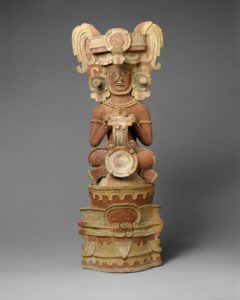The banking model is a way Paulo Freire the education system. This model shows a student as an empty container being filled with knowledge by their educator. This also lets the teachers put whatever they want into the students regardless of the effect it will have students. It takes away some of the creativity of the students because they have to learn what they are told. I noticed that this has happened to me in some classes that I have taken in high school and even some classes now. Some of my professors have all the answers to the question in textbooks and if we have a question they tell us the answers are in the textbooks when we have test the questions come right out of the textbook so it feels similar to the banking model. This might be good because it allows students to learn a lot of information quickly and they could try to apply it to their own work.
Author: Joel Matlala
My Art Story
What we mean when we say art we mean how the art looks and the meaning behind it. We want to see what is going on in the piece if there is something that the artist wanted to display whether it is certain features or a theme in their piece of art. Art is meaningful to me because I have seen a lot of art through my life through myself and friends who enjoy drawing. It fits into my life because I have transitioned into doing a lot of digital art. I feel like I can learn from this class because I can learn about the things the history of art and more importantly the styles that have stayed the same and things that civilizations have enjoyed so I can see if I can incorporate it into my own work.

How to make a post
Step 1) Log onto your account using your cuny common credentials.
Step 2) Click on the “Sites” tab and select a specific site (i.e. Fall 2018 Art 1010 at Brooklyn College)
Step 3) Add yourself to the site (via a button on the left side of the screen that says “Add Me”)
Step 4) Click on the “+New” button on the top of the screen.
Step 5) Write a title and beginning filling in the body as well.
Step 6) Select a category and add a tag. Make sure to choose your class and add relevant tags.
Step 7: Hit the blue “Publish” button when ready to post.
Final project Walking Tour
What I wanted to explore with this final project is the way that rulers were represented by their people through art more specifically sculptures. How differently they were carved, for example, I wanted to see how their facial features differed from region to region. I want to see if the body types are idealistic and unrealistic or if they are plausible and reasonable.
Roman

The Romans never really liked to hold back in their sculptures. They made sure they got the Rulers imperfections in their sculptures because they wanted to be realistic and make sure that people know exactly what their ruler looked like. An example is the piece above is a Bronze statue of the emperor Trebonianus Gallus they didn’t make him look as good as possible they gave him a gut and they made sure to carve in the wrinkles on the face of Trebonianus. Romans were influenced by Greek and Egyptian art when they took over their land. Roman art is usually seen as having less worth to the Greek pieces because the Greek art was first and it looks more ideal.
French
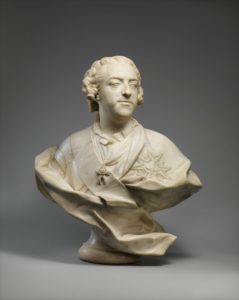
The French enjoyed making their leaders look strong in sculptures. Something that I have noticed when looking over the sculptures is that the leaders are always dressed up in a dignified way. This is a good example of how French leaders were represented. This is Louis XV and the king is shown wearing a suit of armor, a mantle thrown over his left shoulder, with the plaque and the ribbon of the Holy Spirit and the cordon of the Golden Fleece very high-class stuff. This sculpture is also made out of white marble a material that was used by the French in a lot of their early works where they later started to use bronze to sculpt.
Egypt
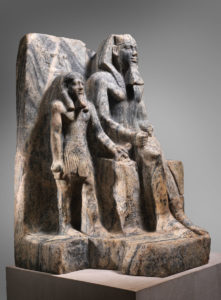
Ancient Egyptians had a very strong connection to religion they made their sculptures with deities from their times. They lived to please their gods so it made sense that they would add gods to their artwork. This has been identified as Sahure, the second ruler of Dynasty 5. Seated on a throne, the king is accompanied by a smaller male figure the local god of the Coptite nome. This deity offers the king an ankh (hieroglyph meaning “life”) with his left hand. This is a great example of Egyptian sculpting because the rulers of Egypt in these days were seen almost as gods. It would make sense that their rulers were Seen as higher than some gods and I think we don’t see a lot of sculptures like this because most other regions like to keep religion out of their sculptures and are more focused on making their leaders look good.
Greek
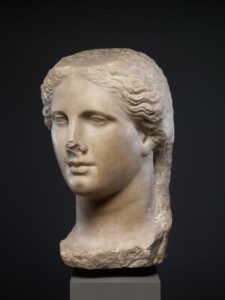
Greeks wanted to be perfect. The sculptures of emperors and royals from Greece usually have perfect figures. They give them 6 packs and a really lean and fit body they take away the imperfections from their faces so that they can look their best. The Greeks change everything that they can in order to make their leaders look perfect and give them this godlike aura they also used marble as it was popular to use. This example is a bit beaten up but you can see how she has no wrinkles unlike the Romans her skin is smooth and her face seems symmetrical and there is detail on her hair. This is showing the head of a Ptolemaic queen and she is really well made which sums up how Greek art is made.
Mayan
Mayan pieces of art are a lot different than anything else on this list because they weren’t really influenced by anyone else here because they were more isolated and didn’t really have contact with Europe. The material looks more like ceramics which is also unique as these other places use marble. Mayans also didn’t really care about looking good which is evident above the facial features aren’t even really even carved out with too much attention. What is shown in this sculpture is that the garments that they wear are important this is a king and his crown is fully carved out and attention to detail was very important as that is what showed dominance.
Conclusion
After looking at all these pieces It is evident that every generation influenced the next. Rulers were represented usually presented very powerful and a lot of these places tended to use marble as material to carve out of. What really connected all the early pieces is the fashion that they had. All the rulers were usually shirtless and wore nothing but their loincloth and their crowns or other pieces of importance. In conclusion, every work of art is unique however, you can see certain features being passed down from culture to culture and see the influence these cultures have had on each other.
Sources
https://www.metmuseum.org/art/collection/search/318345
https://www.metmuseum.org/toah/works-of-art/2002.66/
https://www.metmuseum.org/art/collection/search/543882
https://www.metmuseum.org/art/collection/search/198766
https://www.metmuseum.org/art/collection/search/247117
Final Essay Annotated Bibliography (Second Topic)
Heilbrunn Timeline of Art History
https://www.metmuseum.org/toah/works-of-art/18.2.4/
Heilbrunn Timeline of Art History
https://www.metmuseum.org/toah/works-of-art/05.30/
Heilbrunn Timeline of Art History
https://www.metmuseum.org/art/collection/search/198766
These 3 pieces offer history to my project. With these sources I can better understand the conditions in which these pieces were built and why they were built. It gives us explanations on who these people were and what they have done to get statues built of them. It also helps because each one of these pieces of work come from a different region so we have more pieces to compare from for our project to see differences and similarities.
Roman Portrait Sculpture: Republican through CONSTANTINE
https://www.metmuseum.org/toah/hd/ropo/hd_ropo.htm
This post gives a lesson on the importance of sculptures and it talks about how they come to fruition. This tells us about how these statues were typically made to celebrate a noted military achievement, usually in connection with an official triumph, or to commemorate some worthy political achievement, such as the drafting of a treaty. We also learn about how bad emperors usually did not get one or they got their sculptures destroyed.
Roman Egypt Essay
https://www.metmuseum.org/toah/hd/regy/hd_regy.htm
This was is really important because it ties a connection between the Roman and the Egyptian pieces of work and how they are influenced from each other. Rome’s rule over Egypt officially began with the arrival of Octavian in 30 B.C., following his defeat of Marc Antony and Cleopatra in the battle at Actium. It talks about how once Rome took over a new fascination with its ancient culture became influential. Obelisks and Egyptian-style architecture and sculpture were installed in Roman fora. This led to the changing and development of a new Egyptian style of sculptures and a new Roman style.
Final Project Outline/Background

Date:ca. 1500–1525
Culture:French
Museum: Metropolitan Museum of Art
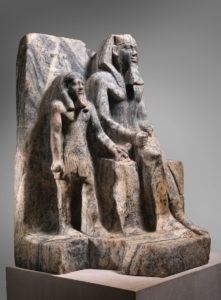
Date:ca. 2458–2446 B.C.
Geography:From Egypt
Museum: Metropolitan Museum of Art

Artist:Jean-Baptiste Lemoyne the Younger (French, Paris 1704–1778 Paris)
Date:1757
Culture:French
Museum: Metropolitan Museum of Art

Date:A.D. 251–253
Culture:Roman
Museum: Metropolitan Museum of Art

Date:ca. 1250
Geography:Made in Burgundy, France
Culture:French
Museum: Metropolitan Museum of Art
Something that is within all the artworks above is the normality of the postures and facials expressions of the subjects used to covey. These are all pieces that are of royals and I chose this because I wanted to see how different types of cultures treat their rulers and how they represent them and preserve their memory through their art.
Unit 2 Summary
Both Greek and Roman art have similarities in the way that they both usually make art that represents their leaders such as sculptures. They both also have many different monuments that honor history that have been made after a significant event.
Something that differentiates Greek and Roman art a lot is that Roman artists did not strive to create perfect representations of human forms. They created sculptures of emperors exaggerating their art to show power of the emperors however something that Romans did was they put into consideration all of the flaws that the rulers had whether it had been saggy skin, skinny, or modest build. The Greeks also made their rulers look very powerful and made them look great however, they made the rulers look perfect like they gave them clear skin a good lean build made them tall and they were also symmetrical. I thought that this Separated them the most because it showed how the Greeks wanted people to look back on them like they were this great genetically perfect species that were powerful and perfect. The Romans wanted people to look back and see exactly what their rulers look like and they wanted people to remember more than anything. This is why roman art felt more genuine when looking at Greek art it makes you say yeah right and you doubt the authenticity of the people that are in the piece of art.
Something that they both have in common is that aesthetic aside they both want to make their rulers look powerful they like to make their rulers the center of attention. Something that looks as if similar is the material that was used to create these sculptures they both look as if they used limestone or marble in order to craft their monuments. Both of these places thrived around the same time period so a lot of their work looks similar and can be mistaken to be from either side.
Both of these look as if they take influence from each other after doing a bit of research Roman art was considered “copied” from the Greeks and that is why it is valued as less than the Greek pieces. I also discovered that both the Greeks and the Romans like to depict the gods although they go by different names in each culture such as Neptune and Poseidon.
Something that these culture have also shown is that they are both very fierce and they are not afraid to show violence in their works and depict how merciless they were in war and how they kill the prisoners in war. Both of these places loved to show how powerful they were and flaunted their power in their works of art they wanted to seem powerful so they would both dishonor the other works of art from other countries by defacing them and making their own pieces of art over them they might even change the face of the pieces of work into the faces of their emperors. Often they would make the most powerful people the biggest in works of art and they would emphasize this so that people can assume the most important people.



Blog Post 6, Brooklyn Museum Ancient World
Part 1:
During my visit to the Brooklyn Museum I went to visit the Egyptian Galleries and I saw this piece of work that I thought was really cool because it didn’t look like it was complete and that mysterious aspect enticed me. This piece was carved onto stone and it looks to have a bunch of ancient Egyptian symbols. It seems to have 2 wealthy looking men or if not that seem to have 2 religious figures I figure that this might be the case because of the Headdresses that they are
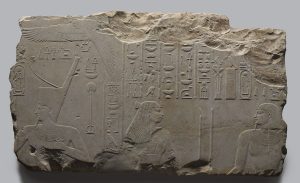
wearing on their heads. On the left there is a eagle flying on top of the hat worn by the man. This is one of the parts that I think are interesting because there seems something that these guys are staring at that is not on this piece that makes me wonder if it is incomplete. Another thing that I noticed is that the 2 people on the left are look intensely at each other they are both holding these rods and holding them close to each other. The Symbols on this piece are also missing near the top it looks like this piece was breaking down before it was taken to the museum.
Part 2:
This piece really spoke to me because it really shows off the culture that we have grown accustomed to in America. The colors on this piece are really vibrant and they really pop out and that was one of the things that really caught my eye. The words in the background seem to be conveying a theme and message that we are free and we should be able to convey our feelings however we chose to. This piece really relates to the rest of the exhibition because a lot of these pieces were really colorful and used a great variety of colors and they all seem to want to portray black culture for what it was and not what people said it was. This exhibition was great because I was able to see many different types of art they all had a different way of showing social aspects of black history and showed things from their perspective.
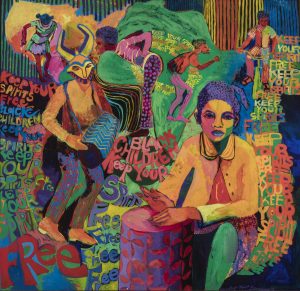
Formal Analysis

Formal analysis is the way you describe a visualization through the use of colors, lines, contrast, position, material, illusion, space and mass. You can use colors because the pallet that the author chose to use in his painting can help determine the mood that the painter was feeling. You can use the the size of certain objects to see the importance of the item to the artist see if they saw it as important. The way things are modeled in a painting are important because you will be able to see how the artist intended for something to be looked at.
